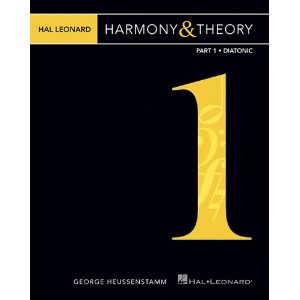
George Heussenstamm, composer of more than 85 published works and author of The Norton Manual of Music Notation, taught college-level theory for several decades. Unable to find what he considered a suitable text, he wrote his own, honing it through practical classroom experience. It is now published for the first time as Hal Leonard Harmony & Theory.
This book is designed for anyone wishing to expand their knowledge of music theory, whether beginner or more advanced. The first two chapters deal with music fundamentals, and may be skipped by those with music reading experience. Each chapter contains many examples that clearly illustrate the concepts presented. Written exercises at the end of each chapter allow the reader to test and apply their knowledge.
Topics include:
- Basic music-reading instruction
- Triads in root position
- Triads in inversion
- Cadences
- Non-harmonic tones
- The dominant seventh chord
- Other seventh chords; and more.
REVIEW ![]()
Hal Leonard Harmony & Theory – Part 1 • Diatonic is a 152-page, paperback book written by George Heussenstamm. The book, which is divided into nine chapters, essentially covers what one would expect to find in the first semester of their college freshman music theory class.
Chapter 1 - Fundamentals introduces basic notation (eg. staff, clefs, accidentals), intervals, major and minor scales, key signatures (circle of fifths), chords, rhythm and note values, and meter.
Chapter 2 - Further Preliminaries addresses diatonic and chromatic harmonies, vocal ranges, chord layouts on the grand staff, and names of scale degrees.
Chapter 3 - Triads in Root Position shows the three methods for connecting chords in various progressions, voice leading, melodic intervals, parallel perfect fifths and octaves, etc.
Chapter 4 - Triads in First Inversion gets into sixth chords, raised sixth degree in minor, and figured bass.
Chapter 5 - Triads in Second Inversion addresses the four types of six-four chords.
Chapter 6 - Cadences covers the various types of cadences, such as the authentic and imperfect authentic cadence, half cadence, plagal cadence, deceptive cadence, and harmonizing a bass line and/or melody.
Chapter 7 - Non-Harmonic Tones, such as passing, neighbor, changing, appoggiatura, escape, anticipation, pedal tones, and suspensions.
Chapter 8 - The Dominant Seventh Chord, one of five types of seventh chords, is discussed. Includes approaching, inversions, and use with figured bass.
Chapter 9 - Other Seventh Chords delves into the supertonic and leading tone seventh chords; the next two most important seventh chords.
Hal Leonard Harmony & Theory – Part 1 • Diatonic contains quite a few music examples throughout, with a number of exercises towards the end of each chapter. The layout is clean and precise; easy to read and well organized.
Having taught music theory at several colleges and music schools, I would recommend Hal Leonard Harmony & Theory – Part 1 • Diatonic for the serious musician who desires to brush up and/or expand their knowledge of music. For the beginner, this book might make for a great tool to use prior or during music study at the college level, however, it is very condensed (although thorough) so beginners will probably require a tutor or instructor to supplement and guide them through the book, as opposed to solely studying alone.




